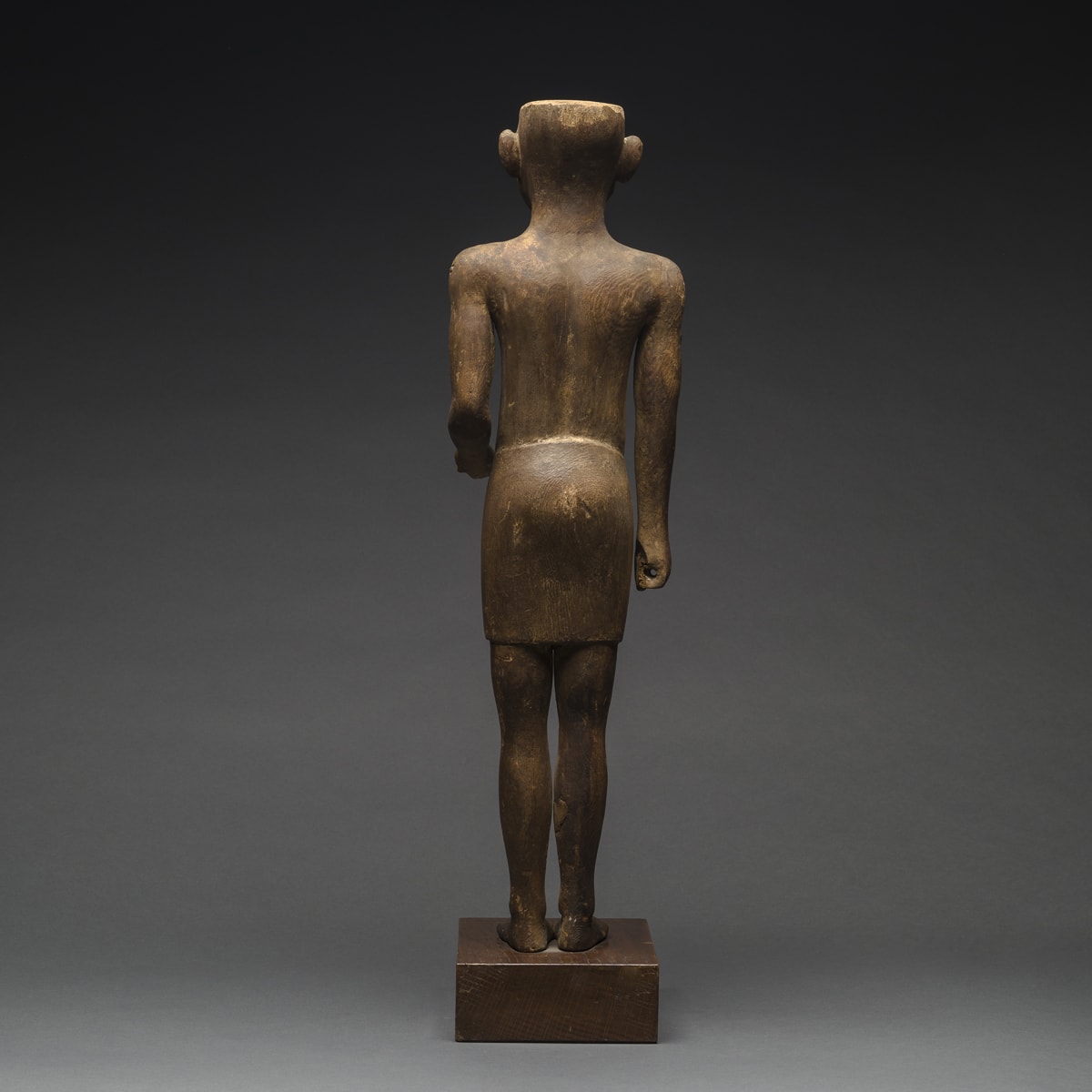New Kingdom Wooden Sculpture of a Standing Man, 1570 BCE - 1070 BCE
Wood
height 48.3 cm
height 19 in
height 19 in
X.0565
Further images
Wooden sculptures from Ancient Egypt are exceedingl rare, since fine wood was scarce and expensive, an preservation is often problematic despite th desiccated environments of stone-cut tombs. On the majority...
Wooden sculptures from Ancient Egypt are exceedingl rare, since fine wood was scarce and expensive, an preservation is often problematic despite th desiccated environments of stone-cut tombs.
On the majority of New Kingdom wooden sculptures t have been recovered, the torso/legs and arms wer carved separately, the arms then being pegged int place. Unusually, the current piece has been carve from a single block of wood. He stands in th distinguished posture characteristic of males in thi period, legs together, the right arm extended by th side with closed fist (pierced to hold a weapon, o perhaps an agricultural implement), the left flexed a the elbow and extended forwards, palm-up. The figur is naked except for a knee-length skirt-lik loincloth; the anatomical details are perfectl rendered in low relief, with well-defined pectoral an biceps muscles. The face is a mask of placidity, th cheeks, eyes, mouth, eyes, eyebrows and ears al picked out in clear detail. The top of the head i angularly flattened, suggesting that the figur originally wore a wig or headdress made from som other material that fit over the wooden form: probabl candidates include bone and ivory. As with all of th rest of the sculpture, there is little radicalism i terms of sculptural interpretation, as was briefly th case under the heretic pharaoh Akhenaten (the husban of Nefertiti, and father allegedly o Tutankhamun). The only tangible effect of his reig was a subsequent slight increase in naturalism an rather less tendency towards stylised formulai reiteration.
There is no hieroglyphic inscription on the figure, s it is impossible to ascertain the identity of th individual portrayed. However, the size of the figure,
the rarity of the material and the care with which i has been carved seem to suggest that it was a individual of some importance. The fact that the ear project to such an extent, and have no wear means tha the missing headpiece was high and narrow. It i therefore possible even likely that the figur depicts a member of the royal family or a pharaoh.
This is a true masterwork of ancient Egyptian art, th value of which is enhanced by its rarity and excellen preservation.
On the majority of New Kingdom wooden sculptures t have been recovered, the torso/legs and arms wer carved separately, the arms then being pegged int place. Unusually, the current piece has been carve from a single block of wood. He stands in th distinguished posture characteristic of males in thi period, legs together, the right arm extended by th side with closed fist (pierced to hold a weapon, o perhaps an agricultural implement), the left flexed a the elbow and extended forwards, palm-up. The figur is naked except for a knee-length skirt-lik loincloth; the anatomical details are perfectl rendered in low relief, with well-defined pectoral an biceps muscles. The face is a mask of placidity, th cheeks, eyes, mouth, eyes, eyebrows and ears al picked out in clear detail. The top of the head i angularly flattened, suggesting that the figur originally wore a wig or headdress made from som other material that fit over the wooden form: probabl candidates include bone and ivory. As with all of th rest of the sculpture, there is little radicalism i terms of sculptural interpretation, as was briefly th case under the heretic pharaoh Akhenaten (the husban of Nefertiti, and father allegedly o Tutankhamun). The only tangible effect of his reig was a subsequent slight increase in naturalism an rather less tendency towards stylised formulai reiteration.
There is no hieroglyphic inscription on the figure, s it is impossible to ascertain the identity of th individual portrayed. However, the size of the figure,
the rarity of the material and the care with which i has been carved seem to suggest that it was a individual of some importance. The fact that the ear project to such an extent, and have no wear means tha the missing headpiece was high and narrow. It i therefore possible even likely that the figur depicts a member of the royal family or a pharaoh.
This is a true masterwork of ancient Egyptian art, th value of which is enhanced by its rarity and excellen preservation.







